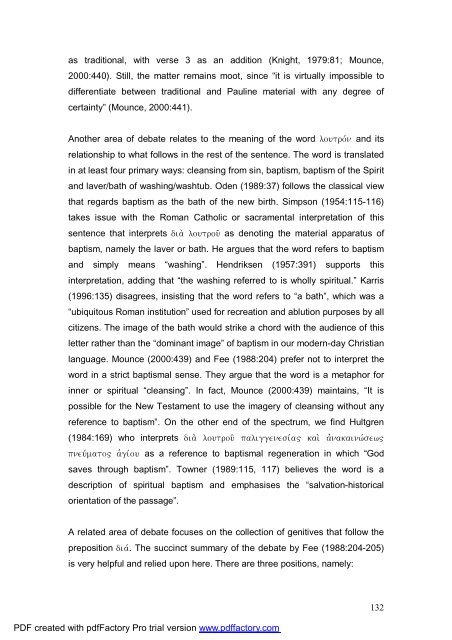A Text centred rhetorical analysis of Paul's Letter to Titus
A Text centred rhetorical analysis of Paul's Letter to Titus
A Text centred rhetorical analysis of Paul's Letter to Titus
You also want an ePaper? Increase the reach of your titles
YUMPU automatically turns print PDFs into web optimized ePapers that Google loves.
as traditional, with verse 3 as an addition (Knight, 1979:81; Mounce,<br />
2000:440). Still, the matter remains moot, since “it is virtually impossible <strong>to</strong><br />
differentiate between traditional and Pauline material with any degree <strong>of</strong><br />
certainty” (Mounce, 2000:441).<br />
Another area <strong>of</strong> debate relates <strong>to</strong> the meaning <strong>of</strong> the word loutrovn and its<br />
relationship <strong>to</strong> what follows in the rest <strong>of</strong> the sentence. The word is translated<br />
in at least four primary ways: cleansing from sin, baptism, baptism <strong>of</strong> the Spirit<br />
and laver/bath <strong>of</strong> washing/washtub. Oden (1989:37) follows the classical view<br />
that regards baptism as the bath <strong>of</strong> the new birth. Simpson (1954:115-116)<br />
takes issue with the Roman Catholic or sacramental interpretation <strong>of</strong> this<br />
sentence that interprets dia; loutrou' as denoting the material apparatus <strong>of</strong><br />
baptism, namely the laver or bath. He argues that the word refers <strong>to</strong> baptism<br />
and simply means “washing”. Hendriksen (1957:391) supports this<br />
interpretation, adding that “the washing referred <strong>to</strong> is wholly spiritual.” Karris<br />
(1996:135) disagrees, insisting that the word refers <strong>to</strong> “a bath”, which was a<br />
“ubiqui<strong>to</strong>us Roman institution” used for recreation and ablution purposes by all<br />
citizens. The image <strong>of</strong> the bath would strike a chord with the audience <strong>of</strong> this<br />
letter rather than the “dominant image” <strong>of</strong> baptism in our modern-day Christian<br />
language. Mounce (2000:439) and Fee (1988:204) prefer not <strong>to</strong> interpret the<br />
word in a strict baptismal sense. They argue that the word is a metaphor for<br />
inner or spiritual “cleansing”. In fact, Mounce (2000:439) maintains, “It is<br />
possible for the New Testament <strong>to</strong> use the imagery <strong>of</strong> cleansing without any<br />
reference <strong>to</strong> baptism”. On the other end <strong>of</strong> the spectrum, we find Hultgren<br />
(1984:169) who interprets dia; loutrou` paliggenesiva" kai; ajnakainwvsew"<br />
pneuvma<strong>to</strong>" aJgivou as a reference <strong>to</strong> baptismal regeneration in which “God<br />
saves through baptism”. Towner (1989:115, 117) believes the word is a<br />
description <strong>of</strong> spiritual baptism and emphasises the “salvation-his<strong>to</strong>rical<br />
orientation <strong>of</strong> the passage”.<br />
A related area <strong>of</strong> debate focuses on the collection <strong>of</strong> genitives that follow the<br />
preposition diav. The succinct summary <strong>of</strong> the debate by Fee (1988:204-205)<br />
is very helpful and relied upon here. There are three positions, namely:<br />
PDF created with pdfFac<strong>to</strong>ry Pro trial version www.pdffac<strong>to</strong>ry.com<br />
132

















